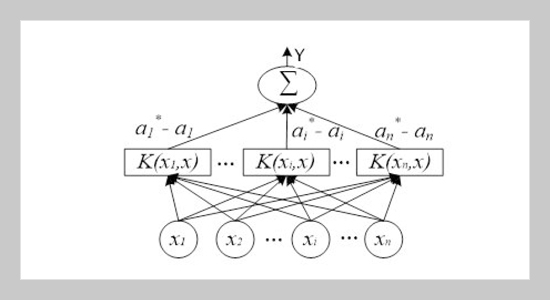REFERENCES
- [1] CHANG Shih-Hsing, Research of Expert System is applied in Automated Lathe Machining. The first automatic control application technology seminar of the Republic of China, March 6, 1993.
- SHANG Ning,QIN Minggui,WANG Yaqin. A BP Neural Network Method for Short-term Traffic Flow Forecasting on Cr6ossroads[J]. Computer Applications and Software,2006, 23(2): 32-33.
- [2] HUANG Darong, SONG Jun, WANG Dacheng, CAO Jianqiu, LI Wei. Forecasting Model of Traffic Flow Based on ARMA and Wavelet Transform[J]. Computer Engineering and Applications, 2006, 6(36): 191-194.
- [3]HAN Chao,SONG Su,WANG Chenghong. A Real-time Short-term Traffic Flow Adaptive Forecasting Method Based on ARIMA Model[J]. JOURNAL OF SYSTEM SIMULATION, 2004, 7(16):1530-1534.
- [4] WANG YI-BING, PAPAGEORGIOUM, MESSMER A. Real-time freeway traffic state estimation based on extended Kalman filter: A general approach [J]. Transportation Research, 2007, 41(2): 167-181.
- [5] Lan Hong li. SHORT-TERM TRAFFIC FLOW PREDICTION FOR HIGHWAY TUNNEL BASED ON FUZZY CLUSTERING ANALYSISP[J]. Computer Applications and Software, 2010, 27(1): 151-153.
- [6] HU Dan, XIAO Jian, CHE Chang. Lifting wavelet support vector machine for traffic flow prediction[J]. Application Research of Computers, 2007, 24(8): 276-278.
- [7] XIE Hong, LIU ZHONGong Hua. Short-term traffic flow prediction based on embedding phase-space and blind signal separation [C].Proceedings of the 2008 IEEE Conference on Cybernetics and IntelligentSystems. [S.L. ]: IEEE Press, 2008: 760-764.
- [8] ShangNing,QinMinggui,WangYaqin,CuiZhongfa,CuiYan,ZhuYangyong. A BP NEURAL NETWORK METHOD FOR SHORT-TERM TRAFFIC FLOW FORECASTING ON CROSSROADS[J] ComputerApplications and Software,2006,23(2):33-35.
- [9] YE Yan,LU Zhi-lin. Neural network short-term traffic flow forecasting model based on particle swarm optimization[J].Computer Engineering and Design, 2009,30(18):4296-4299.
- [10] LIU Hanli, ZHOU Chenghu, ZHU Axing, LI Lin. Multi-Population Genetic Neural Network Model for Short-term Traffic Flow Predictionat Intersections[J]. Acta Geodaetica et Cartographica Sinica, 2009,38(4):364-368.
- [11] CAO J R, CAI A N. A robust shot transition detection method based on support vector machine in compressed domain[J].Pattern Recognition Letters, 2007, 28(12):1534-1540.
- [12] ZHU Sheng-xue, ZHOU Jun, BAO Xu. Short-term Traffic Forecast Based on WD and SVM [J]. University of Science and Technology of Suzhou (Engineering and Technology), 2007, 20(3):80-85.
- [13] Ren Qi-liang,XIE Xiaosong,PENG Qiyuan. GSVMR Model on Short-term Forecasting of City Road Traffic Volume[J]. Journal of Highway and Transportation Research and Development, 2008,2(52):135-138.
- [14] Qi Wu. A hybrid-forecasting model based on Gaussian support vector machine and chaotic particle swarm optimization[J]. Expert Systems with Applications, 2010, 37:2388–2394.
- [15] YAN H S, XU D. An approach to estimating product design time based on fuzzy-support vector machine [J]. IEEE Transactions on Neural Networks, 2007, 18(3):721-731.
- [16] SUN Yuefeng, ZHANG Shenhong, Wang Xiao-ling, MEI Chuanshu. Multi-objective optimization of regional water resources based on mixed genetic algorithm[J]. 2009, 29(1):139-142.
- [17] Abdelhadi, B., Benoudjit, A., & NaitSaid, N. (2003). Self-adaptive genetic algorithms based characterization of structured model parameters. In: Proceedings of the 35th southeastern symposium on system theory, Virginia (pp. 181–185).
- [18] Min, S. H., Lee, J., & Han, I. (2006). Hybrid genetic algorithms and support vector machines for bankruptcy prediction. Expert Systems with Applications, 31(3), 652–660.
- [19] SCH LKOPF B, SMOLA A J, WILLIAMSON R C, etal. New support vector algorithms [J].Neural Computation, 2000,12(5):1207-1245.
- [20] WU Qi, YAN Hongsen. Forecasting method based on support vector machine with Gaussian loss function [J]. Computer Integrated Manufacturing Systems, 2009, 15(2), 306–310.
- [21] YAN H S, XU D. An approach to estimating product design time based on fuzzy ν-support vector machine [J]. IEEE Transactions on Neural Networks, 2007, 18(3):721-731.
- [22] ZHANG Zong fei. Novel Improved Quantum Genetic Algorithm [J]. Computer Engineering, 2010, 36(6):181-183.
- [23] CAO Dao you, CHENG Jia xing. A Genetic Algorithm Based on Modified Selection Operator and Crossover Operator [J]. COMPUTER TECHNOLOGY AND DEVELOPMENT, 2010, 20(2):45-48.
- [24] ZHANG Jig Zhao, JIANG Tao. Improved adaptive genetic algorithm[J]. Computer Engineering and Applications, 2010,46(11):53-55.
- [25] Choi C, Lee J J. Chaotic local search algorithm[J]. Artificial Life and Robotics,1998,2(1):41-47.
- [26] YAO Jun-Feng, MEI Chi, PENG Xiao-Qi.THE APPLICATION RESEARCH OF THE CHAOS GENETIC ALGORITHM(CGA)AND ITS EVALUATION OF OPTIMIZATION EFFICIENCY[J]. ACTA AUTOMATICA SINICA,2002,28(6): 935-942.
- [27] GONG Dun-wei, ZHU Mei-Qiang, GUO Xi-jin, Li Ming. Genetic algorithm based on chaotic mutation to deal with premature convergence[J]. Control and Decision, 2003,18(6): 686 -689.
- [28] WANG Fang, DAI Yong-shou, WANG Shao-shui. Modified chaos-genetic algorithm.Computer Engineering and Applications[J]. Computer Engineering and Applications, 2010,46(6).
- [29] Chen Guan-rong, Mao Yao-bin, Chui C K.A symmetric image encryption scheme based on 3D chaotic cat maps[J].Chaos, Solutions and Fractals, 2004, 21(3):749-761. No in Bib
- [30] Lu Q Z, Shen G L, Yu R Q. A chaotic approach to maintain the population diversity of genetic algorithm in network training [J]. Computational Biology and Chemistry, 2003, 27(3):363.
- [31] Liu B, Wang L, Jin Y H, et al. Improved particle swarm optimization combined with chaos [J]. Chaos Solutions and Fractals, 2005, 25(5):1261.
- [32] LI Dey,i MENG Haijun, SHI Xueme.i Membership clouds and membership cloud generators[J]. Journal of Computer Research and Development, 1995, 32(6): 15-2.
- [33] Li Xing-sheng, LiDeyi. A NEW METHOD BASED ON CLOUD MODEL FOR DISCRETIZATION OF CONTINUOUS ATTRIBUTES IN ROUGH SETS [J]. PR&Al, 2003: 16-19.
- [34] LIU Changyu, LIDey, i DU Y,i et a. Some statistical analysis of the normal cloud model [J]. Information and Control, 2005,4(2): 236-239.
- [35] Hsu, C. C., Wang, K. S., & Chang, S. H., Bayesian decision theory for support vector machines: Imbalance measurement and feature optimization, Expert Systems With Applications, Vol. 38, no. 5, pp. 4698-4704, May 2011.
- [36] Hsu, C. C., Wang,. K. S., Chung, H. T., & Chang, S. H., A Study of visual behavior of multidimensional scaling for kernel perceptron algorithm, Neural Computing and Applications, Vol. 26, no. 3, pp. 679-691, 2015.
- [37] Taylor, J.W. Short-term load forecasting with exponentially weighted methods. IEEE Trans. Power Syst. 2012, 27, 458–464.
















